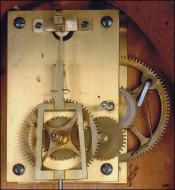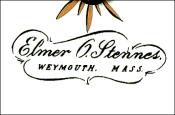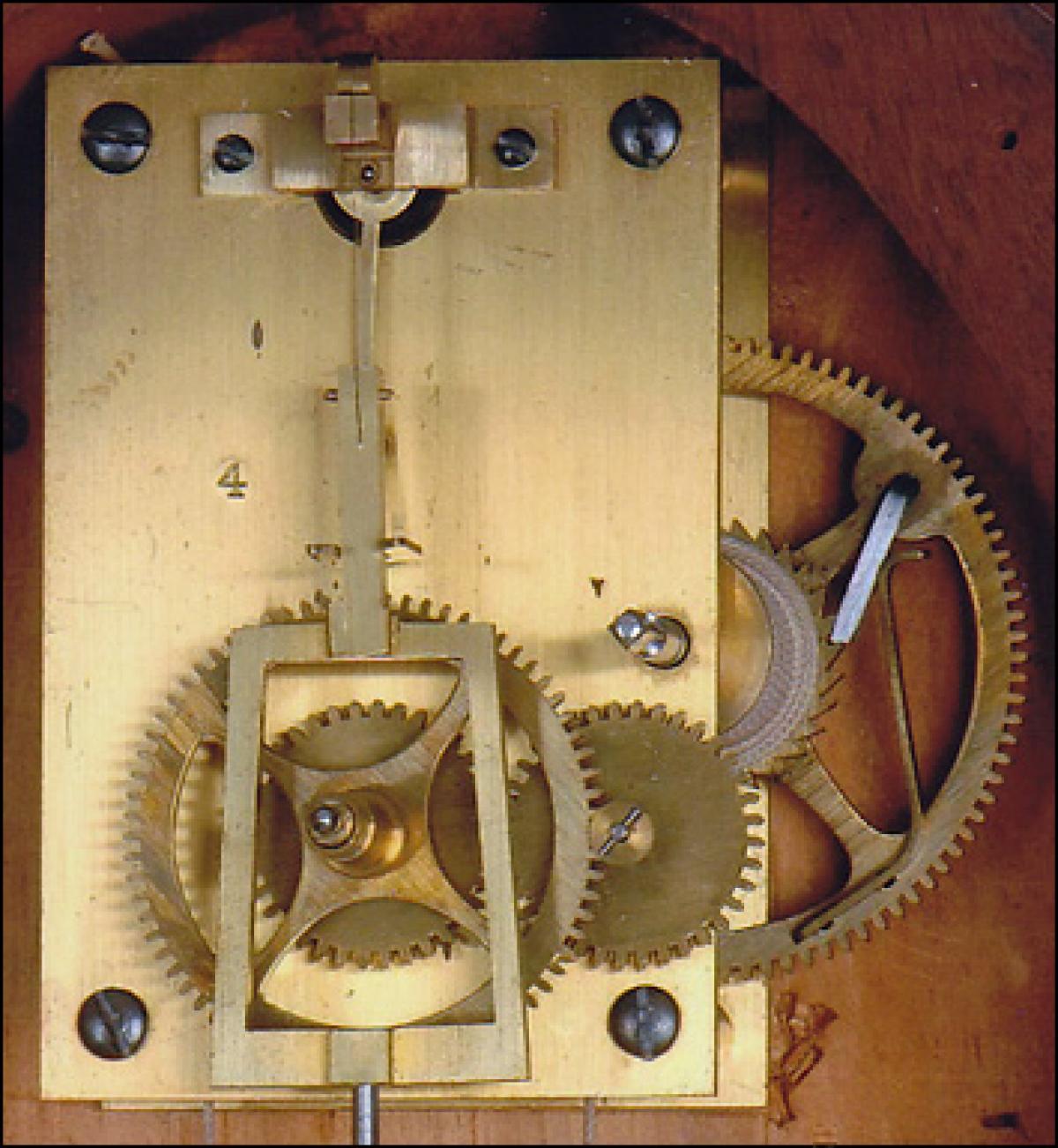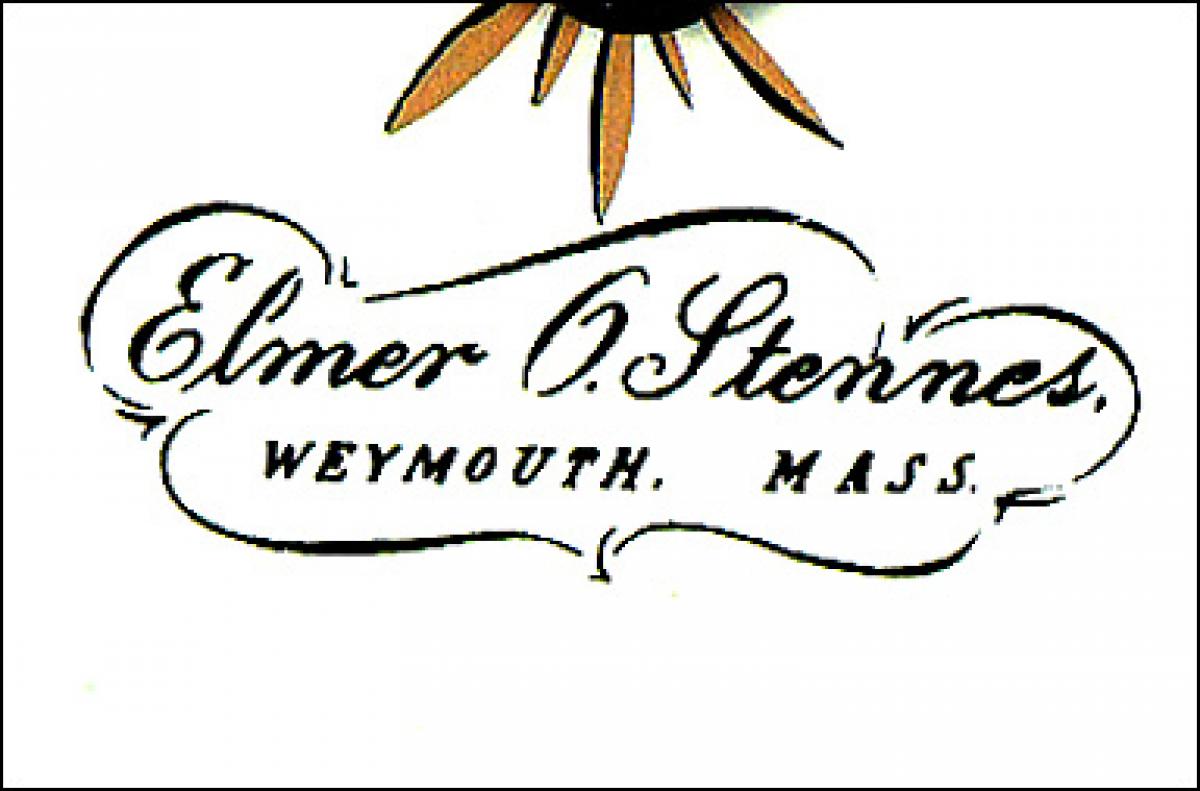Elmer Stennes. Reproduction Girandole wall timepiece. OO-26.
This is an outstanding reproduction of the Girandole Wall Timepiece made by Elmer Stennes of East Weymouth, Massachusetts. The Concord, Massachusetts, Clockmaker Lemuel Curtis made this form famous.
In 1802, Lemuel Curtis was an apprentice of the Willard family in Boston. In 1811, he moved to Concord and set up shop as a Clockmaker specializing in timepieces. Over the years, he made many improvements in the Willard original design. An example of such an improvement is the single screw movement mounting system and changes to the clock suspension. His ultimate achievement would have to be the design of this Girandole form. However, this was not a financial success. As a result, a small number were originally produced. Most of which are in the collections of our Country’s best museums. Many individuals and some companies have since made reproductions of this form. Some of these include the Waltham Clock Company, Ted Burleigh and Foster Campos. This is a faithful copy of the original form.
This wonderful example is in excellent condition. It is signed on the dial by the Maker in script lettering. This case measures forty-five inches long. The case wood used is mahogany. The rich brown coloring of the wood can be best seen on the sides of the case. The sidearms and the bezel are brass. (The sidearms are the decorations fitted to the case's sides. The bezel forms the door that allows one access to the dial.) The frames that hold the two reverse-painted tablets, the carved wooden eagle finial, and the ornately formed presentation bracket are wonderfully gilded in gold leaf. The condition of the gilding is excellent. The reverse-painted tablets are done in very good colors. Both pieces of glass are in a convex form. The throat is an intricate traditional theme signed “Patent” in the lower section. The bottom circular tablet depicts “Aurora” and is so titled. The dial is painted on metal and features the Maker’s signature and working location. The format of this dial is done in the traditional Concord format, having a gold ring. Below the 6:12 position on the time ring, one will notice a small bee painted on the dial. The hands are a traditional Curtis form, having concentric circles and barbed pointers. The movement is brass and die-stamped with the numeral “4” on the front plate. This fine-quality movement is weight-powered and designed to run for eight days on a full wind. This is truly an excellent example of a beautiful clock.
Inventory number OO-26.
Elmer Osbourne Stennes was born in Somerville, Massachusetts, on June 9, 1911. After high school, he attended the Wentworth Institute in Boston during the 1933 - 1934 school year. From Wentworth, Stennes received a certificate stating he had completed a special course in carpentry and architectural drawing. This document is signed by the Principal, Frederick E. Dobbs. During WW-II, Stennes worked as a cabinetmaker/patternmaker and ship model builder at Forge River in the Quincy, Massachusetts shipyards. After the war, Stennes, a skilled woodworker, became interested in making clocks; by the late 1940s, he was at it full-time. His business evolved. He built the cases for the clocks he sold. These were always of very good quality and nicely finished. Stennes' cases were copies of popular clocks made in the early 1800s by well-known clockmakers, including the Willards, Lemuel Curtis, Joshua Wilder, Rueben Tower, and Abel Hutchins. Stennes was not a clockmaker. As a result, he sourced many of the movements and components from whole used clocks he purchased. At the time, the more common E. Howard products like the model numbers 5 and 70 were inexpensive. He would buy clocks like these for the components and discard their cases. He also used various spare movements that he could buy through the trade. In the early days, the tablets were painted by Edwin Burt of Auburndale. He had an Assistant hired under the G I Bill named Clinton Bates. Stennes signed the dials of the clocks he made with his name and marketed them as his own. Stennes sold many clocks at retail outlets like Shreve, Crump & Low in Boston and through the network he developed in the National Association of Clock and Watch Collectors (N.A.W.C.C.). He was an active member, and the numerous meetings and marts were, at the time, busy places of trade. His reputation grew as his clocks were attractive, available, and reasonably priced.
Many of the forms that Stennes copied were of clocks that were difficult to come by and often very expensive when they did turn up in the marketplace. One example of this is his copy of Lemuel Curtis's girandole clock. Of course, his business model evolved over the years. He made a wide variety of forms, including the Willard-style timepiece or banjo clock, one of his best sellers. His copies of Lemuel Curtis's Girandole also sold well and are still very popular today. Later, he expanded his catalog and made several shelf clock forms and versions of the tall case clock or grandfather clock, including the grandmother's version and an in-between size he called the Wessagusset. The Wessagusset model was named after the Native American name for the Weymouth shore. In addition to clocks, Stennes made a small amount of furniture. As clock collecting grew in popularity, companies were formed to supply the needs of the hobby. Soon, the movement and component manufacturers began to supply the trade. Stennes began to patronize their stores for parts.
By 1959, Stennes had built a barn on his property to set up his workshop. He told people his shop was located at No., 1 Tic Tock Lane. I remember visiting there as a young boy.
Elmer Stennes may be better known today for his actions on December 2, 1968. After an argument with his second wife, Eva, Elmer shot her in the head with his pistol in the kitchen of their home. Stennes called the Weymouth police and told them what he had done. He was arrested in his home and later released on $25,000 bond. While free on bond, Stennes continued to make clocks. He signed the clocks made during this period with the initials "O.O.B." This was to signify that the clock was made while he was out on bond. During his trial, Stennes pleaded not guilty to murder but admitted guilt to manslaughter. He was sentenced to eight to ten years in prison for this crime. This was to be served at the Massachusetts Correctional Institute at Plymouth (M.C.I.P.) He was incarcerated at M.C.I.P. in October of 1969. Stennes was well-connected politically. Soon, he was put in charge of the woodworking shop at the prison. Foster Compos, Stennes's full-time employee, once told me that he would visit him on weekends and pick up the cases that were made at the prison that week. Foster would then assemble them in the Weymouth shop and then sell them. The clocks made during this period were marked M.C. I. P. In less than four years, Stennes was paroled on January 12, 1973. In December of that year, he married Phyllis Means on the 15th. Almost two years later, on October 4, 1975, the couple was shot multiple times while they were sleeping in their bedroom. Two men broke into their house. Elmer was shot five times and killed. Phyllis was shot seven times and survived by rolling off the bed and playing dead on the floor. Phyllis later accused her 24-year-old stepson Elliot of being one of the shooters. She had retold the story to people I knew that she recognized his voice when he said, "This is for my mom." While in court, Elliot had five witnesses testify that they were together in a bar in Franconia, New Hampshire, at the time of the shooting. As a result, the charges against him were dropped. This case has never been solved.
I would like to thank David Howard for helping this Elmer Stennes biography.






